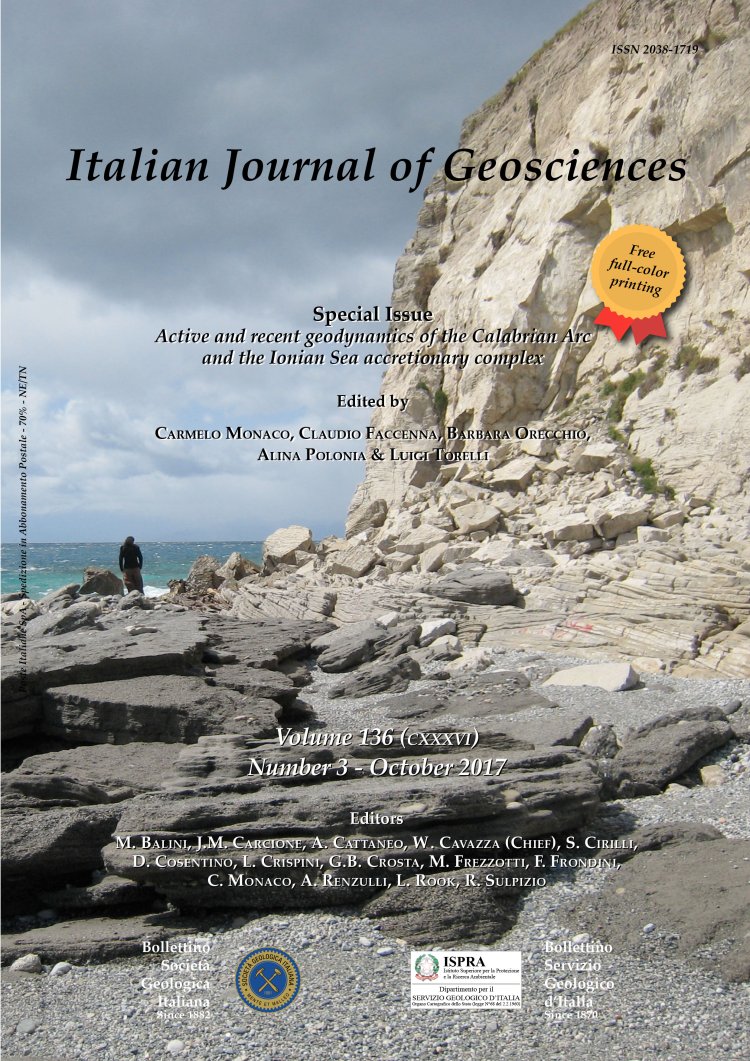
Structural style of Quaternary extension in the Crati Valley (Calabrian Arc): Evidence in support of an east-dipping detachment fault
Francesco Brozzetti (1), Daniele Cirillo (1), Francesca Liberi (1), Eugenio Piluso (2), Elena Faraca (3), Rita De Nardis (1) & Giusy Lavecchia (1)
(1) CRUST - Università G. d'Annunzio, Via dei Vestini - 66013 Chieti. Corresponding author e-mail: f.brozzetti@dst.unich.it.
(2) DIBEST, Università della Calabria, Ponte P. Bucci, Cubo 15b, - 87036 Arcavacata di Rende, Cosenza.
(3) Libero Professionista, Luzzi, Cosenza.
Volume: 136 (2017) f.3
Pages: 434-453
Abstract
New geological field data, integrated with commercial seismic lines, allowed us to constrain the geometry and time-space evolution of the fault system that ruled the tectono-sedimentary evolution of the NS-striking Crati graben, in the axial portion of the northern Calabrian Arc.
We highlight that this basin is controlled by a 60-km long east-dipping master fault, referred to as the Crati Graben Detachment Fault (CGDF).
On the seismic sections, the CGDF appears as an east-dipping low-angle reflection reaching the surface along the eastern slope of the Catena Costiera Calabra. Its surface expression corresponds to an alignment of moderately-inclined (30° to 45°) left-stepping en-échelon faults.
More to the East, a number of E- and W-dipping high-angle normal faults branch upward from the CGDF. Their reconstructed timing suggest that the westernmost faults are active since the Early Pleistocene and show a progressive eastward rejuvenation trend.
The conversion to depth of a W-E oriented seismic section, crossing the entire Crati graben, highlights that the CGDF has a staircase geometry, with an average angle of 30°, and reaches a depth of 7-8 km below the east side of the basin. The evolutionary stages of the related fault system were reconstructed by restoring the section through the Move suite software (Midland Valley Exploration), in order to verify the kinematic consistency of our subsurface interpretation and estimate the amount of associate extension.
Finally, the present activity and the possible seismogenic role of the CGDF is preliminarily discussed, by comparing the geometry of the extensional fault system with the available historical and seismological instrumental datasets.
We highlight that this basin is controlled by a 60-km long east-dipping master fault, referred to as the Crati Graben Detachment Fault (CGDF).
On the seismic sections, the CGDF appears as an east-dipping low-angle reflection reaching the surface along the eastern slope of the Catena Costiera Calabra. Its surface expression corresponds to an alignment of moderately-inclined (30° to 45°) left-stepping en-échelon faults.
More to the East, a number of E- and W-dipping high-angle normal faults branch upward from the CGDF. Their reconstructed timing suggest that the westernmost faults are active since the Early Pleistocene and show a progressive eastward rejuvenation trend.
The conversion to depth of a W-E oriented seismic section, crossing the entire Crati graben, highlights that the CGDF has a staircase geometry, with an average angle of 30°, and reaches a depth of 7-8 km below the east side of the basin. The evolutionary stages of the related fault system were reconstructed by restoring the section through the Move suite software (Midland Valley Exploration), in order to verify the kinematic consistency of our subsurface interpretation and estimate the amount of associate extension.
Finally, the present activity and the possible seismogenic role of the CGDF is preliminarily discussed, by comparing the geometry of the extensional fault system with the available historical and seismological instrumental datasets.
Keywords
northern Calabrian Arc, Italian extensional bel, low-lngle normal faults, seismic lines interpretation, seismotectonics.
Get Full Text Attached